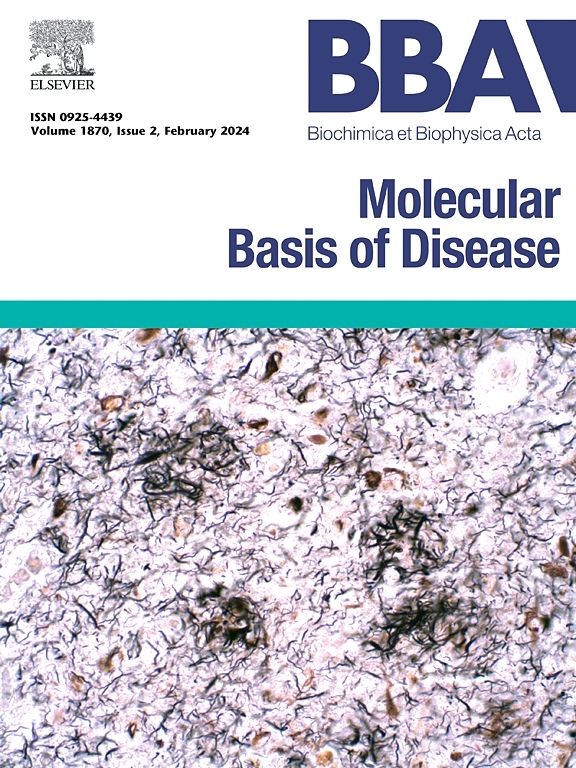Therapeutic potential of GNRHR analogs and SRC/FAK inhibitors to counteract tumor growth and metastasis in breast cancer
IF 4.2
2区 生物学
Q2 BIOCHEMISTRY & MOLECULAR BIOLOGY
Biochimica et biophysica acta. Molecular basis of disease
Pub Date : 2025-04-04
DOI:10.1016/j.bbadis.2025.167826
引用次数: 0
Abstract
Breast cancer (BC) is the leading cause of cancer death in women, with hormone-dependent BC accounting for about 80 % of cases, primarily affecting postmenopausal women with gonadotropins, luteinizing hormone (LH), and follicle-stimulating hormone (FSH) elevated. Treatments targeting the gonadotropin-releasing hormone receptor (GnRHR), such as the agonist leuprorelin (LEU) and antagonist degarelix (DEGA), are used for hormone-dependent tumors. While the functional role of gonadotropin receptors in extragonadal tissues remains uncertain, recent studies suggest LH contributes to tumor development and progression. Tumor progression involves reorganization in the actin cytoskeleton, induction of adhesion, and cell migration, driven by proteins such as Src and the focal adhesion kinase (FAK), which are related to invasive behaviors. The overexpression of both protein kinases generates an invasive and metastatic phenotype, then inhibitors targeting Src (PP2) and FAK (FAKi) have been developed to counteract this effect. This study combined GnRH analogs with Src and FAK inhibitors to target BC progression. We found that LH treatment influenced gene expression linked to tumor development. Examining the GnRHR-LEU and GnRHR-DEGA complexes revealed structural differences affecting ligand binding. In an orthotopic tumor model, DEGA reduced tumor growth, while LEU had the opposite effect. Combining DEGA with PP2 or FAKi enhanced tumor inhibition, improving mice survival. These findings provide valuable insights into the essential regulatory role of gonadotropins in genes involved in tumorigenic processes, highlighting the potential of GnRHR antagonists combined with Src or FAK inhibitors as a promising strategy to develop new drugs that interfere with the ability of breast tumor progression.

GNRHR类似物和SRC/FAK抑制剂抑制乳腺癌肿瘤生长和转移的治疗潜力
乳腺癌(BC)是女性癌症死亡的主要原因,激素依赖性BC约占80%的病例,主要影响绝经后促性腺激素、促黄体生成素(LH)和促卵泡激素(FSH)升高的妇女。针对促性腺激素释放激素受体(GnRHR)的治疗,如激动剂leuprorelin (LEU)和拮抗剂degarelix (DEGA),用于激素依赖性肿瘤。虽然促性腺激素受体在腺外组织中的功能作用仍不确定,但最近的研究表明LH有助于肿瘤的发生和进展。肿瘤进展涉及肌动蛋白细胞骨架的重组、粘附诱导和细胞迁移,由Src和局灶粘附激酶(FAK)等蛋白驱动,这些蛋白与侵袭行为有关。这两种蛋白激酶的过表达产生侵袭性和转移性表型,然后针对Src (PP2)和FAK (FAKi)的抑制剂被开发来抵消这种影响。该研究将GnRH类似物与Src和FAK抑制剂联合用于靶向BC进展。我们发现黄体生成素治疗影响了与肿瘤发展相关的基因表达。检查GnRHR-LEU和GnRHR-DEGA配合物发现结构差异影响配体结合。在原位肿瘤模型中,DEGA抑制肿瘤生长,而LEU具有相反的作用。DEGA联合PP2或FAKi可增强肿瘤抑制,提高小鼠存活率。这些发现为了解促性腺激素在参与致瘤过程的基因中的重要调节作用提供了有价值的见解,突出了GnRHR拮抗剂与Src或FAK抑制剂联合使用的潜力,作为开发干扰乳腺肿瘤进展能力的新药的有希望的策略。
本文章由计算机程序翻译,如有差异,请以英文原文为准。
求助全文
约1分钟内获得全文
求助全文
来源期刊
CiteScore
12.30
自引率
0.00%
发文量
218
审稿时长
32 days
期刊介绍:
BBA Molecular Basis of Disease addresses the biochemistry and molecular genetics of disease processes and models of human disease. This journal covers aspects of aging, cancer, metabolic-, neurological-, and immunological-based disease. Manuscripts focused on using animal models to elucidate biochemical and mechanistic insight in each of these conditions, are particularly encouraged. Manuscripts should emphasize the underlying mechanisms of disease pathways and provide novel contributions to the understanding and/or treatment of these disorders. Highly descriptive and method development submissions may be declined without full review. The submission of uninvited reviews to BBA - Molecular Basis of Disease is strongly discouraged, and any such uninvited review should be accompanied by a coverletter outlining the compelling reasons why the review should be considered.

 求助内容:
求助内容: 应助结果提醒方式:
应助结果提醒方式:


